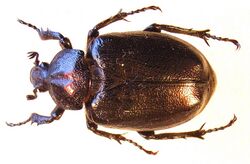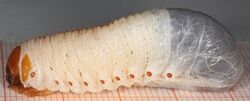Biology:Osmoderma eremita
| Osmoderma eremita | |
|---|---|

| |
| Adult female | |

| |
| Larva | |
| Scientific classification | |
| Domain: | Eukaryota |
| Kingdom: | Animalia |
| Phylum: | Arthropoda |
| Class: | Insecta |
| Order: | Coleoptera |
| Family: | Scarabaeidae |
| Genus: | Osmoderma |
| Species: | O. eremita
|
| Binomial name | |
| Osmoderma eremita (Scopoli, 1763)
| |
Osmoderma eremita, the hermit beetle or Russian leather beetle,[2] is a species of European beetle in the family Scarabaeidae. Adults reach between 28 and 32 mm in length.[3]
Distribution
Osmoderma eremita can be found everywhere in Europe, except for the United Kingdom , Iceland, Ireland, Malta, Portugal, and San Marino.[4]
Larvae
The larvae develop in hollow trees. Oak is the preferred kind of tree, but the larvae may develop in any tree species with suitable hollows.[2] Due to extensive scientific research, O. eremita is the most well known insect species associated with ancient or hollow trees. For instance, research has addressed the beetles' dispersal biology,[5] population dynamics,[6] and chemical communication.[7] Trained conservation detection dogs are being used in monitoring larvae in Italy.[8]
Conservation status
Due to habitat loss and fragmentation, the species has decreased all over its distribution range. For this reason the species is protected in most European countries, and has been given the highest priority according to the EU's Habitats Directive.[2] LIFE's projects in Poodří, Czech Republic and Gipuzkoa, Spain led by Arnika, Ostrava University and Aranzadi Science Societyaimed at expanding the habitat of this endangered species.[9][10]
References
- ↑ Nieto, A.; Mannerkoski, I.; Putchkov, A.; Tykarski, P.; Mason, F.; Dodelin, B.; Tezcan, S. (2010). "Osmoderma eremita". IUCN Red List of Threatened Species 2010: e.T15632A105873655. doi:10.2305/IUCN.UK.2010-1.RLTS.T15632A105873655.en. https://www.iucnredlist.org/species/15632/105873655. Retrieved 12 November 2021.
- ↑ 2.0 2.1 2.2 "Hermit beetle (Osmoderma eremita)". ARKive. http://www.arkive.org/hermit-beetle/osmoderma-eremita/info.html.
- ↑ http://www.catedu.es/arablogs/blog.php?id_blog=1556&id_articulo=79542 [|permanent dead link|dead link}}]
- ↑ "Osmoderma eremita (Scopoli, 1763)". Fauna Europaea. http://www.faunaeur.org/full_results.php?id=246970.
- ↑ Hedin, Jonas (2008). "Restricted dispersal in a flying beetle assessed by telemetry.". Biodiversity and Conservation 17 (3): 675–684. doi:10.1007/s10531-007-9299-7. https://pub.epsilon.slu.se/8040/1/hedin_j_110408.pdf.
- ↑ Ranius, Thomas (2001). "Constancy and asynchrony of Osmoderma eremita populations in tree hollows". Oecologia 126 (2): 208–215. doi:10.1007/s004420000515. PMID 28547619. Bibcode: 2001Oecol.126..208R. https://pub.epsilon.slu.se/8055/1/ranius_t_110414.pdf.
- ↑ Larsson, Mattias (2003). "The characteristic odour of Osmoderma eremita (Coleoptera: Scarabaeidae) identified as a male-released pheromone.". Journal of Chemical Ecology 29 (3): 575–587. doi:10.1023/A:1022850704500. PMID 12757320.
- ↑ Mosconi, Fabio; Campanaro, Alessandro; Carpaneto, Giuseppe Maria; Chiari, Stefano; Hardersen, Sönke; Mancini, Emiliano; Maurizi, Emanuela; Sabatelli, Simone et al. (2017). "Training of a dog for the monitoring of Osmoderma eremita". Nature Conservation (Pensoft) 20: 237–264. doi:10.3897/natureconservation.20.12688. ISSN 1314-3301.
- ↑ Kočárek, Petr; Klemensová, Marcela; Aubrechtová, Tereza; Kaláb, Oto (February 2020). "Ochrana páchníka hnědého (Osmoderma barnabita) v CHKO Poodří". https://www.researchgate.net/publication/344339376_Ochrana_pachnika_hnedeho_Osmoderma_barnabita_v_CHKO_Poodri.
- ↑ Castro, Alberto (December 2012). "LIFE Project: Management and conservation of Osmoderma eremita, Rosalia alpina and other saproxylic habitats of Community interest in Gipuzkoa". https://www.researchgate.net/publication/367435039_LIFE_Project_Management_and_conservation_of_Osmoderma_eremita_Rosalia_alpina_and_other_saproxylic_habitats_of_Community_interest_in_Gipuzkoa?channel=doi&linkId=63d25dbde922c50e99c634d1&showFulltext=true.
External links
- Species summary
- Encyclopedia of Life: Osmoderma eremita distribution
- LIFE Rosalia: Osmoderma eremita
Wikidata ☰ Q1141328 entry
 |


